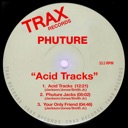House
A DJ performing at a dance club
Matty Adame omgitsmattyvee, CC0, via Wikimedia CommonsKey Attributes of House
Select to filter timelineThemes
- Nightlife/Parties
- Travel
- LGBTQ
- Racism/Discrimination
- Community
- Dance
- Love/Relationships
- Religion/Faith
Musical Features
- Timbre
- Beat
- Vocals
- Verse/Refrain
- Call and Response
- Electronic Sounds
- Rhythms
Instruments
- Bass
- Electric Piano/Synthesizer
- Other Electronic Instruments
- Other Percussion
House music is a form of electronic dance music produced by DJs and musicians using analog and digital electronic musical instruments like synthesizers, drum machines, samplers, and sequencers, as well as multi-track mixers. It is characterized by a funky 4/4 bass beat and prominent high-hat fills. House music engages the African Diasporic aesthetic of emphasizing the second and fourth pulses of each measure. Vocal lines are typically sung by women about spirituality, love, and celebration; although much of house music is instrumental with complex melodies, rhythmic patterns, and timbres. House music is played in dance clubs, at outdoor festivals, on concert hall stages, and on the radio all over the world.
Context and History
House music, built on the foundations of disco and experimental electronic music, has flourished underground in Chicago, Detroit, and New York City with varying levels of popularity since the 1970s and its influence can be heard in many different styles of popular music. With roots in New York City’s Black gay 1970s club scene, Chicago and Detroit’s nighttime dance communities were, and are, extremely diverse with African American, Latinx, Asian American, and white women, men, and transgender DJs, musicians, dancers, and fans. DJs Larry Levan in New York City, Frankie Knuckles in Chicago, and Ken Collier in Detroit created major dance music scenes in their respective cities.
In the late 1970s, declining record sales and musical creativity, as well as increasing homophobia and racism, led to diminished popularity for disco. House and techno music picked up where a more underground disco culture might have been headed. In New York City, clubs like Paradise Garage where Larry Levan played records, led the way in creating massive party spaces that embraced all sex and gender identities, loud music, dancing, and fashion. In the club, Levan often played his own electronic music productions and remixes that he composed and recorded in his home studio. Some of these were released on vinyl and for sale in New York City record stores and around the world; others were limited pressings on vinyl so that only Levan, or select DJs, could play them in a DJ set. Paradise Garage and Larry Levan inspired dance club culture to grow in Midwestern cities. The distance between Detroit and Chicago, and New York City, made it easy for young people to make weekend DJing, dancing, and record collecting trips, returning home with new sounds and ideas.
DJ Frankie Knuckles of the Bronx, and resident DJ with Levan at Paradise Garage, brought New York City’s club culture, DJing styles, and catalog of sounds to Chicago in 1977, beginning his residency at the Warehouse dance club operated by Robert Williams. Black radio, record pools, and Chicago’s early club culture welcomed Knuckles’s DJ sensibilities and house music releases while mingling with Detroit’s Black club culture and early techno music production. Soon, record stores in Chicago were labelling sections of records “as heard at the Warehouse,” for sale. Both the club name and record store sales category led to the naming of this form of electronic music, “house” music. The Midwest and New York formed a globally recognized dance music hub in the late-1970s and 1980s, a foundation that continues to nourish contemporary electronic music culture around the world.
In Detroit, Ken Collier played records at clubs like Zana’s Place, Chessmate, Heaven, Todd’s, and Detroit’s Studio 54 in the late-1970s and through the 1980s, building the foundations of electronic music and club culture in Detroit. In the 1970s, club music that would soon be called house and techno, was initially called “progressive” music in Detroit. These records had fewer vocals and pop music formulae than disco, and more abstract sounds and sonic concepts, while continuing to drive the party on the dance floor. Collier was known for hosting excellent dance parties, sometimes mixing records for ten hours for the dancers, whom he sometimes referred to as his children if he got on the mic during a DJ set. Stacey Hotwaxx Hale, Al Ester, John Collins, Duane Bradley, and Felton Howard are a few of Detroit’s DJs who worked and partied with Collier, and now continue to influence Detroit’s electronic dance music culture with consistent DJing and event organization in Detroit, music production, mentoring, radio engagement, and archiving and education.
By the 1980s, Chicago emerged as a leader in house music culture with a vibrant social complex of radio, dance clubs, record stores, and record labels. House music radio shows could be heard on WBMX (call letters stand for Black Music Experience) and WGCI; disc jockeys like Farley Jackmaster Funk and Steve Silk Hurley played records by Chicago house creators like Chip E., Jesse Saunders, Marshall Jefferson, Phuture, DJ Pierre, and Frankie Knuckles, and featured on-air guest appearances by many prominent Chicago house DJs. Ron Hardy and Larry Heard, two renowned Chicago DJs, propelled house music onto a global sound stage in the 1980s and 1990s, DJing parties, dance clubs, and raves around the world, as well as influencing local record sales and club culture in Chicago and Detroit. From 1982 to 1987, Robert Williams, Robert Owens, Ron Hardy, and Marshall Jefferson operated the Music Box dance club in Chicago. Much like the Warehouse, Music Box contributed to Chicago’s rich dance club culture by creating a space with notable DJs playing exciting dance music that attracted great dancers and fans. Record companies and record labels are both involved in the promotion and distribution of house music, and some labels become known as trusted sources, much like any independent music industry. Trax Records, DJ International Records, Cajual Records, and Dance Mania are four popular and successful Chicago-based record labels whose house music releases featuring all of the Chicago house musicians listed above, could be found in the record bags of top DJs around the world, as well as on the walls of Chicago record stores like Imports, Etc. and Gramaphone.
From the 1980s into the 2000s, house music in Detroit paralleled the development of techno music, with many musicians producing both house and techno. Members of the House (Mike Banks, Jeff Mills, Bill Beaver, and a rotating membership), Aaron-Carl, Mike Clark, Norm Talley, Alton Miller, Delano Smith, Malik Alston, Andrés, Kyle Hall, Terrence Parker, Rick Wilhite, Minx, Diviniti, Piranahead, Marcellus Pittman, Theo Parrish, Omar-S, and Moodymann, all prolific house music producers and DJs, helped build the local electronic music scene in Detroit. These DJs and musicians run Detroit’s independent music industry, recording, mastering, DJing, and distributing electronic music in Detroit and around the world.
Many prominent music festivals and large-scale events feature house music around the United States. Since 1990, Chosen Few House Music Picnic has been held in Chicago every summer. It is an outdoor weekend festival featuring house music DJs and producers like Jesse Saunders, Steve Silk Hurley, and DJ Spinna. DJ Spinna, a house DJ from New York, often hosts large-scale, themed Michael Jackson parties, Stevie Wonder parties, or Prince parties, at which all of the music he plays are originals and house remixes of that artist. The Backpack Music Festival, formerly the Detroit House Music Picnic, is held in Detroit annually since 2005 to raise money and supplies for local school children. Moodymann, Juan Atkins, and Kevin Saunderson are some of the artists who volunteer to play this festival regularly. Soul Skate, a biennial house music and roller skating weekend event in Detroit since 2007 hosted by Moodymann, has helped Detroit continue to grow as a tourist destination during Memorial Day weekend. This is the same weekend as the Movement Festival; a three-day outdoor electronic music festival happening in Detroit since 2001 featuring nearly every Detroit house and techno musician to ever touch a record. Charivari, a three-day house and techno festival in Detroit, is a newer annual event in August, the first in 2013. Rick Wilhite, DJ Minx, and Stacey Hotwaxx Hale are just a few Detroiters who DJ this festival.
The worldwide popularity of American house music has led to vibrant regional house music scenes in South Africa, Japan, and the UK, with influential DJs, widespread mixtape culture, historically significant dance clubs and DJ residencies in clubs, and events featuring the musicians and DJs introduced above.
Musical Features/Performance Style
Like disco, house music typically emphasizes each pulse of a four-beat measure played on the kick-drum, a characteristic referred to as “four-on-the-floor.” House music producers often layer multiple rhythmic and melodic patterns over this four-beat measure to create a rich, danceable sound. House music beats per minute fall into the 120 to 135 range; other musical features include prominent high-hat cymbal fills, female or male vocals, electronic distortion, and other experimental timbres and patterns.
House musicians often use drum machines, and computer programs like Propellerhead Reason, that offer a wide range of distortion along with musical production capabilities. These drum machines, like the Roland TR-303, TR-808, or TR-909, generate a raw, unpolished aesthetic as heard in “Move Your Body (the House Music Anthem)” by Marshall Jefferson (1986). In his early productions, Frankie Knuckles edited and manipulated the tempos of soul and funk recordings over which he layered percussion instruments. His “Let the Music Use You” is an example of house music aesthetics. In Detroit, artists like Moodymann, Omar S, and Theo Parrish (a Chicago native), have propelled house music into the 2000s with innovative sampling, instrument use, and musical themes. Moodymann in particular is an intellectually driven electronic music artist pushing listeners to understand dance music, and Black music, in new ways, layering messages of resistance and revolution throughout his career. His records address Detroit’s 1967 race rebellion, contemporary racism, and resistance through celebration using vocal samples, soul, funk, and jazz samples, recordings of African American demonstrative church services, recordings of Detroit radio, and his own compositions on drum machine, synthesizer, and other electronic and acoustic instruments.
Lyrics
Although primarily an instrumental form, house music that includes vocals intersperses refrain lines throughout; lyrics encourage celebration, spirituality, dancing, and community engagement. Some house songs are structured like a pop song with verse and chorus form; some lyrical patterns are more repetitive in a call and response form.
Bibliography
- Fikentscher, Kai. “Disco and House” in Mellonee V. Burnim and Portia K. Maultsby, eds. 2nd edition. African American Music: An Introduction. New York: Routledge Press, 2015, p. 320-334.















